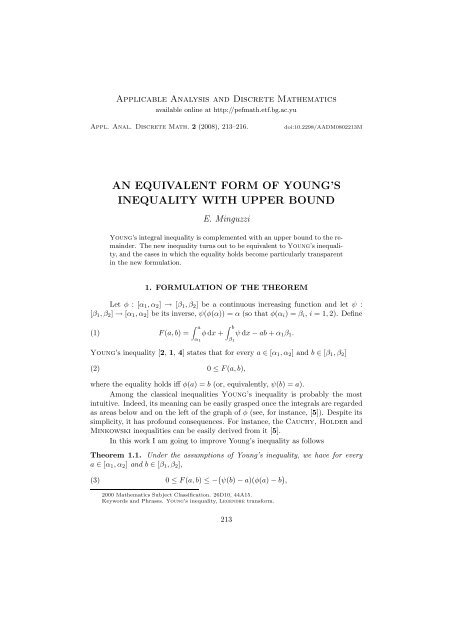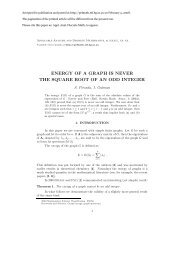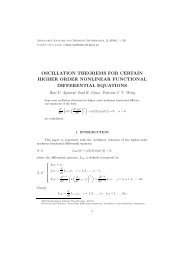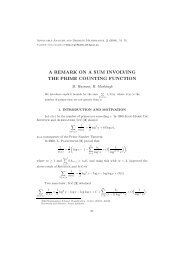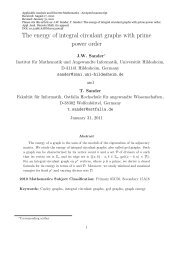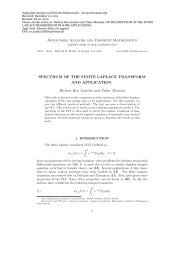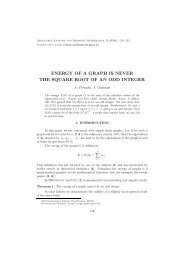an equivalent form of young's inequality with upper bound - doiSerbia
an equivalent form of young's inequality with upper bound - doiSerbia
an equivalent form of young's inequality with upper bound - doiSerbia
You also want an ePaper? Increase the reach of your titles
YUMPU automatically turns print PDFs into web optimized ePapers that Google loves.
Applicable Analysis <strong>an</strong>d Discrete Mathematics<br />
available online at http://pefmath.etf.bg.ac.yu<br />
Appl. Anal. Discrete Math. 2 (2008), 213–216.<br />
doi:10.2298/AADM0802213M<br />
AN EQUIVALENT FORM OF YOUNG’S<br />
INEQUALITY WITH UPPER BOUND<br />
E. Minguzzi<br />
Young’s integral <strong>inequality</strong> is complemented <strong>with</strong> <strong>an</strong> <strong>upper</strong> <strong>bound</strong> to the remainder.<br />
The new <strong>inequality</strong> turns out to be <strong>equivalent</strong> to Young’s <strong>inequality</strong>,<br />
<strong>an</strong>d the cases in which the equality holds become particularly tr<strong>an</strong>sparent<br />
in the new <strong>form</strong>ulation.<br />
1. FORMULATION OF THE THEOREM<br />
Let φ : [α 1 , α 2 ] → [β 1 , β 2 ] be a continuous increasing function <strong>an</strong>d let ψ :<br />
[β 1 , β 2 ] → [α 1 , α 2 ] be its inverse, ψ(φ(α)) = α (so that φ(α i ) = β i , i = 1, 2). Define<br />
∫ a ∫ b<br />
(1) F(a, b) = φdx +<br />
α 1<br />
ψ dx − ab + α 1 β 1 .<br />
β 1<br />
Young’s <strong>inequality</strong> [2, 1, 4] states that for every a ∈ [α 1 , α 2 ] <strong>an</strong>d b ∈ [β 1 , β 2 ]<br />
(2) 0 ≤ F(a, b),<br />
where the equality holds iff φ(a) = b (or, <strong>equivalent</strong>ly, ψ(b) = a).<br />
Among the classical inequalities Young’s <strong>inequality</strong> is probably the most<br />
intuitive. Indeed, its me<strong>an</strong>ing c<strong>an</strong> be easily grasped once the integrals are regarded<br />
as areas below <strong>an</strong>d on the left <strong>of</strong> the graph <strong>of</strong> φ (see, for inst<strong>an</strong>ce, [5]). Despite its<br />
simplicity, it has pr<strong>of</strong>ound consequences. For inst<strong>an</strong>ce, the Cauchy, Holder <strong>an</strong>d<br />
Minkowski inequalities c<strong>an</strong> be easily derived from it [5].<br />
In this work I am going to improve Young’s <strong>inequality</strong> as follows<br />
Theorem 1.1. Under the assumptions <strong>of</strong> Young’s <strong>inequality</strong>, we have for every<br />
a ∈ [α 1 , α 2 ] <strong>an</strong>d b ∈ [β 1 , β 2 ],<br />
(3) 0 ≤ F(a, b) ≤ − ( ψ(b) − a)(φ(a) − b ) ,<br />
2000 Mathematics Subject Classification. 26D10, 44A15.<br />
Keywords <strong>an</strong>d Phrases. Young’s <strong>inequality</strong>, Legendre tr<strong>an</strong>s<strong>form</strong>.<br />
213
214 E. Minguzzi<br />
where the <strong>form</strong>er equality holds if <strong>an</strong>d only if the latter equality holds.<br />
Note that the theorem contains Young’s <strong>inequality</strong> as a special case, <strong>with</strong><br />
the adv<strong>an</strong>tage that the equality case is naturally taken into account by the special<br />
<strong>form</strong> <strong>of</strong> the <strong>upper</strong> <strong>bound</strong>. For inst<strong>an</strong>ce, if ψ(b) = a then F(a, b) = 0 which is<br />
one <strong>of</strong> the additional statements contained in the classical <strong>form</strong>ulation <strong>of</strong> Young’s<br />
<strong>inequality</strong>. Nevertheless, I will not prove again Young’s <strong>inequality</strong>, instead I will<br />
use it repeatedly to obtain the extended version given by theorem 1.1.<br />
Remark 1.2. Over the years several extensions <strong>of</strong> Young’s <strong>inequality</strong> have been considered.<br />
A good account is given by [4]. Among those only M. Merkle’s contribution<br />
[3] seems to go in the same direction considered by this work. Theorem 1.1 improves<br />
Merkle’s result, which in the case α 1 = β 1 = 0 states that (notation <strong>of</strong> this work)<br />
F(a,b) ≤ max{aφ(a),bψ(b)} − ab.<br />
Indeed, the last term <strong>of</strong> (3) c<strong>an</strong> be rewritten<br />
(<br />
aφ(a) + bψ(b) − φ(a)ψ(b)<br />
)<br />
− ab,<br />
<strong>an</strong>d we have only to show that<br />
aφ(a) + bψ(b) − φ(a)ψ(b) ≤ max{aφ(a), bψ(b)},<br />
<strong>an</strong>d that for some a,b, the <strong>inequality</strong> is strict. Indeed, if φ(a) > b then, since φ <strong>an</strong>d ψ are<br />
one the inverse <strong>of</strong> the other, a > ψ(b) <strong>an</strong>d thus aφ(a) > bψ(b). Then<br />
aφ(a) + bψ(b) − φ(a)ψ(b) = aφ(a) + ( b − φ(a) ) ψ(b) < aφ(a) = max{aφ(a),bψ(b)}.<br />
The case φ(a) < b gives again a strict <strong>inequality</strong> while the case φ(a) = b gives <strong>an</strong> equality.<br />
2. THE PROOF<br />
The pro<strong>of</strong> <strong>of</strong> theorem 1.1 is based on the next lemma<br />
Lemma 2.1. For every a, ã ∈ [α 1 , α 2 ] <strong>an</strong>d b,˜b ∈ [β 1 , β 2 ], we have<br />
(4) F(a, b) + F(ã,˜b) ≥ −(ã − a)(˜b − b),<br />
where the equality holds iff ã = ψ(b) <strong>an</strong>d ˜b = φ(a).<br />
Pro<strong>of</strong>. Young’s <strong>inequality</strong> gives<br />
(5)<br />
(6)<br />
∫ a<br />
then (∫ a ∫ )<br />
b<br />
φdx + ψ dx − ab + α 1 β 1<br />
α 1 β 1<br />
=<br />
( ∫ a<br />
α 1<br />
φdx +<br />
∫ ˜b<br />
∫ ˜b<br />
φdx + ψ dx + α 1 β 1 ≥ a˜b<br />
α 1 β 1<br />
∫ ã ∫ b<br />
φdx + ψ dx + α 1 β 1 ≥ ãb<br />
α 1 β 1<br />
)<br />
ψ dx + α 1 β 1 +<br />
β 1<br />
( ∫ ã<br />
+<br />
∫ )<br />
˜b<br />
φdx + ψ dx − ã˜b + α 1 β 1<br />
α 1 β 1<br />
∫ )<br />
b<br />
φdx + ψ dx + α 1 β 1 − ab − ã ˜b<br />
α 1 β 1<br />
( ∫ ã<br />
≥ a˜b + ãb − ab − ã˜b = −(ã − a)(˜b − b).
An <strong>equivalent</strong> <strong>form</strong> <strong>of</strong> Young’s <strong>inequality</strong> <strong>with</strong> <strong>upper</strong> <strong>bound</strong> 215<br />
□<br />
The equality holds iff it holds in (5) <strong>an</strong>d (6), that is iff ã = ψ(b) <strong>an</strong>d ˜b = φ(a).<br />
We are ready to prove the theorem.<br />
Pro<strong>of</strong> <strong>of</strong> theorem 1.1. Consider (4) <strong>with</strong> ã = ψ(b) <strong>an</strong>d ˜b = φ(a)<br />
F(a, b) + F ( ψ(b), φ(a) ) = − ( ψ(b) − a )( φ(a) − b ) .<br />
By Young’s <strong>inequality</strong>, since ψ(b) ∈ [α 1 , α 2 ] <strong>an</strong>d φ(a) ∈ [β 1 , β 2 ], F ( ψ(b), φ(a) ) ≥ 0,<br />
thus<br />
F(a, b) ≤ − ( φ(a) − b )( ψ(b) − a ) .<br />
The equality holds iff F ( ψ(b), φ(a) ) = 0 which holds, again by the usual Young’s<br />
<strong>inequality</strong>, iff φ ( ψ(b) ) = φ(a) i.e. b = φ(a) (or <strong>equivalent</strong>ly a = ψ(b)), which holds<br />
iff the <strong>inequality</strong> F(a, b) ≥ 0 is actually <strong>an</strong> equality.<br />
□<br />
3. THE LEGENDRE TRANSFORM<br />
It is worthwhile to recall the connection <strong>with</strong> the Legendre tr<strong>an</strong>s<strong>form</strong>. If<br />
Φ : [α 1 , α 2 ] → R <strong>an</strong>d Ψ : [β 1 , β 2 ] → R are two C 1 functions <strong>with</strong> increasing<br />
derivatives such that they are the Legendre tr<strong>an</strong>s<strong>form</strong> <strong>of</strong> each other then it is<br />
well known that they admit the integral representation Φ(a) = Φ(α 1 ) + ∫ a<br />
α 1<br />
φdx,<br />
Ψ(b) = Ψ(β 1 ) + ∫ b<br />
β 1<br />
ψ dx where φ <strong>an</strong>d ψ are two C 0 increasing function which are<br />
one the inverse <strong>of</strong> the other, β 1 = φ(α 1 ) <strong>an</strong>d Φ(α 1 ) + Ψ(β 1 ) = α 1 β 1 . Thus the<br />
theorem for the Legendre tr<strong>an</strong>s<strong>form</strong>s case takes the following <strong>form</strong>:<br />
Theorem 3.1. If Φ : [α 1 , α 2 ] → R <strong>an</strong>d Ψ : [β 1 , β 2 ] → R are two C 1 functions <strong>with</strong><br />
increasing derivatives such that they are the Legendre tr<strong>an</strong>s<strong>form</strong> <strong>of</strong> each other, then<br />
for every a ∈ [α 1 , α 2 ], b ∈ [β 1 , β 2 ]<br />
(7) 0 ≤ Φ(a) + Ψ(b) − ab ≤ − ( Φ ′ (a) − b )( Ψ ′ (b) − a ) ,<br />
where the <strong>form</strong>er equality holds iff the latter equality holds.<br />
Example 3.2. Take Φ(a) = aα α <strong>an</strong>d Ψ(b) = bβ β <strong>with</strong> 1 α + 1 β<br />
obtain the inequalities<br />
= 1, <strong>an</strong>d α, β > 1, then we<br />
(8) 0 ≤ aα α + bβ β − ab ≤ −(aα−1 − b)(b β−1 − a),<br />
in particular the last <strong>inequality</strong> c<strong>an</strong> be rewritten<br />
b β−1 a α−1 ≤ 1 α bβ + 1 β aα = 1 α (bβ−1 ) α + 1 β (aα−1 ) β ,<br />
that is, it has as expected the same <strong>form</strong> <strong>of</strong> Young’s <strong>inequality</strong>.<br />
Acknowledgments. This work has been partially supported by GNFM <strong>of</strong> INDAM<br />
<strong>an</strong>d by MIUR under project PRIN 2005 from Università di Camerino.
216 E. Minguzzi<br />
REFERENCES<br />
1. J. B. Diaz, F. T. Metcalf: An <strong>an</strong>alytic pro<strong>of</strong> <strong>of</strong> Young’s <strong>inequality</strong>. Amer. Math.<br />
Monthly, 77 (1970), 603–609.<br />
2. G. H. Hardy, J. E. Littlewood, G. Pólya: Inequalities. Cambridge University<br />
Press, Cambridge, 1934.<br />
3. M. Merkle: A contribution to Young’s <strong>inequality</strong>. Univ. Beograd. Publ. Elektrotehn.<br />
Fak. Ser. Mat. Fiz., 461–497 (1974), 265–267.<br />
4. D. S. Mitrinović, J. E. Pečarić, A. M. Fink: Classical <strong>an</strong>d new inequalities in<br />
<strong>an</strong>alysis. Kluwer Academic Publishers, Dordrecht, 1993.<br />
5. E. Tolsted: An elementary derivation <strong>of</strong> the Cauchy, Holder, <strong>an</strong>d Minkowski inequalities<br />
from Young’s <strong>inequality</strong>. Math. Mag., 37 (1964), 2–12.<br />
Department <strong>of</strong> Applied Mathematics, (Received February 11, 2008)<br />
Florence University, Via S. Marta 3, (Revised July 26, 2008)<br />
I-50139 Florence, Italy<br />
E–mail: ettore.minguzzi@unifi.it


